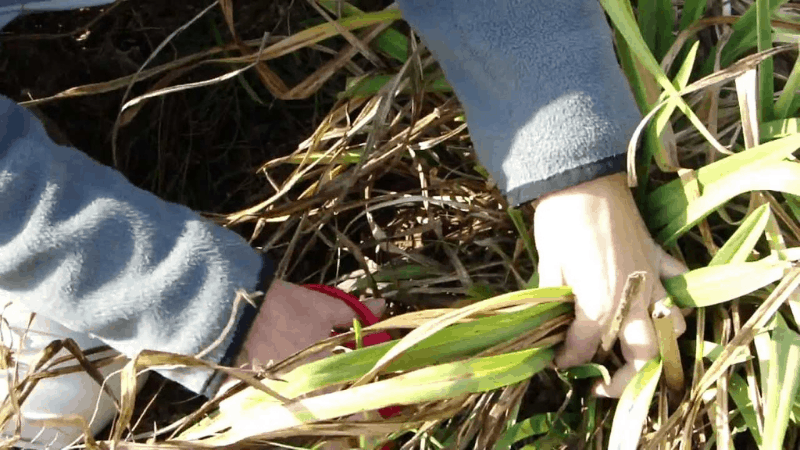How Can You Mow Over Daylilies? – Expert’s Advice
by Lee Safin
I have been growing beautiful daylilies over the years. It has become a common habit for me to routinely mowing over daylilies. With long-term experience, I have learned how to do it effectively so that daylilies can grow healthily. In this post, I will answer the question of “how can you mow over daylilies?” step-by-step.
How Can You Mow Over Daylilies?
You can mow over daylilies simply using the best pruning shear and by lopping off the leaves at about 5 to 6 in (13 to 15 cm). Daylilies need to be planted a minimum of six inches (15 cm) apart. Here we discussed more on “How Can You Mow Over Daylilies From Scapes.”
Mowing over daylilies is an easy-breezy task. All you need to do is lift the leaves where they originate from the plant’s crown. Then, take your pruners and a clip and get close to the ground level without damaging the plant’s crown. Make sure you don’t leave any stubs when cutting the plants back.
Read More – Best Fluorescent Grow Lights
However, keeping daylilies under control requires learning a lot of things. If you want to know about them, you need to scroll down for the next few minutes. Just read on!
Daylilies can be mowed over in a couple of ways. A few of them are highlighted in the list below.
Contents
- How Can You Mow Over Daylilies in Early Spring?
- How Can You Mow Over Daylilies From Scapes?
- What To Do If Blossoms Starts Dying?
- How To Keep Lilies Protected From Weeds?
- When To Trim Daylilies For Winter?
- How To Trim Daylilies in Winter?
- If I continue to mow down daylilies will they finally go away?
- When to mow over daylilies?
- Wrapping Up

How Can You Mow Over Daylilies in Early Spring?

A suitable method you can follow to mow over daylilies is diving in the early spring plants.
Step 1
For your daylilies, be sure to dig out all the roots. Try to locate the base of the plants underneath the patch of daylily plants with your shovel.
You should carefully displace dead daylilies and roots beneath the plant by applying enough pressure. Move the plant base entirely into a flat area with your shovel, then dig up the soil underneath.
Step 2
Leaves on the daylily plants should be cut down after they are dead. Whenever possible, lop off the leaves at about 5 to 6 in (13 to 15 cm). Divvying up the individual plants will be much easier.
Step 3
Organize the daylily plants by fanning and separating them. Break up the large dirt pile using a compact gardening rake.
Separate the root systems from the stems by using this instrument. Plant stems that are coiled together can be separated and fanned out by placing your fingers between them.
Step 4
Daylilies need to be planted a minimum of six inches (15 cm) apart. You can boost the soil’s fertility by tilling it and applying slow-release fertilizer.
The hole should be large enough for the roots to fit into if you want to replant the daylilies comfortably. To ensure your daylilies grow correctly, keep them separate.
Step 5
Replant the daylilies after they have been watered. Water the new transplants by soaking the soil around their base. A weekly average of 1 inch (2.5 cm) of water is best suited for your plants. You can protect newly planted plants by putting straw mulch on top or spreading shredded leaves during the winter.
How Can You Mow Over Daylilies From Scapes?
Mowing over daylilies is a simple task when you know the correct method.

Step 1
Flowers bloom on stalks and stems, which are called the scapes. Using pruning shears, you can trim the scapes at the base. Additionally, you can wait for the scapes to break off with a simple tug on its collar.
Step 2
The first frost should be cut back with a pair of pruning shears during the fall or when leaves brown. Not more than five centimeters (15 inches) below the soil is the recommended depth for cutting them off.
Don’t forget to clean and sanitize the knife or shears you are using to mow over them. It will prevent spreading diseases.
If you are more interested to know “how to sharpen a shear“, check the linked article.
Step 3
Leaves and scapes should similarly be removed and disposed of. It will prevent the material from cluttering the ground. Pests have a great place to live in it!
You can grow them in your house with the help of a grow bag. To get the best grow bag, check our latest article.
What To Do If Blossoms Starts Dying?
Step 1
If any blossoms die during the season, simply use your fingers to rub off them. When your daylilies bloom during the spring, check out each blossom individually for signs of drooping or death.
Snap any dead flower heads from the rest of the plant by pinching them with your fingers. There is no requirement to check them daily— once or twice a week is enough.
Step 2
Get rid of any damaged or dead leaves on your daylily. Ensure your plants are regularly checked for signs of leaf streak disease, which may appear as brown streaks. Trim any leaves with pruning shears that are deformed if you notice them.
How To Keep Lilies Protected From Weeds?

To keep daylilies protected with mulch to prevent weeds, you can purchase ground bark chips or pine straw from the gardening supply store. The mulch should be applied under the plant’s base to stop the growth of weeds
When To Trim Daylilies For Winter?
The last method you can use to mow over daylilies is winterizing the plants.
How To Trim Daylilies in Winter?

Step 1
Pick out the dead leaves from the daylily plants. To prevent your daylilies from rotting in the winter, be sure to remove them in autumn.
Take a handful of dead leaves out of the dirt and grasp them with gardening gloves on. Make sure this clump is entirely removed by tugging. Then follow the same procedure to eliminate other dead leaves from the closest place.
Step 2
On the flower’s base, you’ll find the crown of the daylily. The daylily stems should be found amidst a mound of dead flowers.
Using your fingers, separate the fallen leaves if you have not done so yet. The plant base or white crown becomes easy to discover with this process.
Step 3
Use pruning shears to snip the crowns. The shears should be positioned about 2.4 to 5 cm on top of the plant.
No dead leaves should be attached to the crown. Avoid removing or cutting the while crown. Because it may discourage the flower from regrowing.
If I continue to mow down daylilies will they finally go away?
I have already heard this question several times: If I continue to mow down daylilies will they finally go away?
Daylilies will not go away if you continue to mow down them. In fact, those who wish to keep daylilies routinely mow them. Because it is daylilies nature to return each year.
These plants reproduce like dahlias under the ground. Hence, as long as there are tubers/roots, daylilies still exist.
Once the mowing process is completed, make sure to use a decent quality yet light-blocking weed barrier to cover them. Then add a layer of mulch of four to six inches to smother them.
Repeating this in a few years is necessary. Alternatively, they can also be dug up and replaced with new soil. Here, day lily roots will become new plants with each piece.
Hopefully, the confusion on “If I continue to mow down daylilies will they finally go away?” has cleared away.
When to mow over daylilies?
Annual mowing over of daylilies is the minimum requirement. It helps to maintain a clean environment. By doing so, pests or pathogens are prevented from developing or at least reduced. You can either choose early spring or late fall to mow over daylilies.
For fall cleanup, you should wait until the first hard frost to cut the leaves. If you want to do it in spring, the vegetation should be trimmed either before or just after the new leaves appear from the ground.
The daylily is evergreen in some varieties. Besides not browning as quickly, these can be left on the plants for spring. During the summer, you can also trim your perennial beds to keep them neat and tidy.
Dead leaves or blooms can be removed as often as they dry out or wilt. Late summer is an excellent time to make a concerted effort because a second flush of blooms occurs. Don’t try to mow over them thoroughly before early spring or late fall comes.
Wrapping Up
Though growing daylilies require less maintenance, we should mow over them from time to time. It will help our beautiful plants to grow healthily and produce more charming flowers in the following years.
But avoid mowing them over unnecessarily especially, the newly forming central leaves. Because it may damage the plant crown and prevent natural growth.
So, how can you mow over daylilies? Hopefully, we got you covered everything about the topic. Happy reading!
 |
 |
 |
 |

About Lee Safin
Lee Safin was born near Sacramento, California on a prune growing farm. His parents were immigrants from Russia who had fled the Bolshevik Revolution. They were determined to give their children a better life than they had known. Education was the key for Lee and his siblings, so they could make their own way in the world. Lee attended five universities, where he studied plant sciences and soil technologies. He also has many years of experience in the U.S. Department of Agriculture as a commercial fertilizer formulator.
Thoughts on "How Can You Mow Over Daylilies? – Expert’s Advice"
 |
 |
 |
 |
Get FREE Gardening Gifts now. Or latest free toolsets from our best collections.
Disable Ad block to get all the secrets. Once done, hit any button below
 |
 |
 |
 |